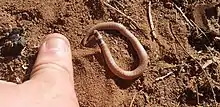| Brachyurophis australis | |
|---|---|
.jpg.webp) | |
 | |
| Scientific classification | |
| Domain: | Eukaryota |
| Kingdom: | Animalia |
| Phylum: | Chordata |
| Class: | Reptilia |
| Order: | Squamata |
| Suborder: | Serpentes |
| Family: | Elapidae |
| Genus: | Brachyurophis |
| Species: | B. autralis |
| Binomial name | |
| Brachyurophis autralis Krefft, 1864 | |
| Synonyms[3] | |
|
Simotes australis Krefft, 1864 | |
Brachyurophis australis (coral snake)[4] is a species of snake from the family Elapidae (common names - eastern shovel-nosed snake, coral snake, Australian coral snake)[3] and is a species endemic to Australia.[1] Its common name reflects its shovel nose specialisation.
Description
The eastern shovel-nosed snake is a small snake. The top of its body is pink or orange to reddish-brown[5] with irregular narrow cross-bands of cream with dark edges.[6][7] It has two large dark bands; one across its head and the other across its nape. Its underside is whitish.[7] The average length of a coral snake is 30cm, and maximum length is 45cm.[6] It has an upturned blunt snout.[5]
Taxonomy
Brachyurophis australis is one of eight currently recognised species within the genus Brachyurophis.[8][9] It was first described by Gerard Krefft in 1864 as Simotes australis.[3][10]
B. australis is differentiated by B. fasciolatus (both occurring in New South Wales) by facial features. In B. australis the nasal scale and preocular scale are in contact and the profile of the snout is more pointed; in B. fasciolatus the nasal scale and preocular scale are separated by the prefrontal scale and the snout appears more rounded in profile.[7]
Distribution & habitat
Brachyurophis australis is found in eastern Australia, in South Australia, Victoria, inland New South Wales and Queensland.[1]
Distribution is from central South to eastern South Australia, North Western Victoria, mostly East of the Great Dividing Range in New South Wales and into Queensland up to Townsville, although found the coast in North East New South Wales and South East Queensland.[7][5] Preferred habitat for the coral snake is open woodland, grassland and arid scrub[7] in mulga, brigalow, open woodland and mallee associations on heavy clay, rocky or sandy soils.[5] The eastern shovel-nosed snake has a burrowing habit and can be found under rocks, logs, or leaf litter during the day.[7]
Behaviour & Diet
The eastern shovel-nosed snake is a burrowing species, its “shovel” shaped nose is an adaptation to its fossorial habits. It is nocturnal and can be spotted on the surface of the ground at night. Its diet consists of lizards and reptile eggs. It is considered venomous but virtually harmless.[6][5]
Reproduction
The eastern shovel-nosed snake is oviparous, laying 4-6 eggs in a clutch.[6][5]
Conservation status
The conservation status of B. australis is assessed by the Queensland Government as being of "Least Concern"[2] and is similarly assessed by the IUCN.[1]
References
- 1 2 3 4 Sanderson, C., Venz, M. & Greenlees, M. (12 June 2017). "Brachyurophis australis". IUCN The IUCN Red List of Threatened Species. Retrieved 10 September 2020.
{{cite journal}}: CS1 maint: multiple names: authors list (link) - 1 2 "Species profile : Brachyurophis australis". apps.des.qld.gov.au. 20 October 2014. Retrieved 10 September 2020.
- 1 2 3 "Brachyurophis australis (Krefft, 1864)". Reptile database. Retrieved 10 September 2020.
- ↑ "Australian Faunal Directory: Brachyurophis australis". biodiversity.org.au. Archived from the original on 9 October 2021. Retrieved 7 October 2021.
- 1 2 3 4 5 6 Eipper, Scott; Eipper, Tyese (2019). A Naturalists Guide to the Snakes of Australia (1st ed.). John Beaufoy Publishing Ltd. ISBN 9781912081509.
- 1 2 3 4 Swan, Gerry (2017). Reed Concise Guide: Snakes of Australia (1st ed.). Reed New Holland Publishers Pty Ltd. pp. 91–92. ISBN 9781921517891.
- 1 2 3 4 5 6 Swan, Glenn; Sadlier, Ross; Shea, Glenn (2017). A Field Guide to Reptiles of NSW (3rd ed.). Reed New Holland Publishers Pty Ltd. ISBN 9781925546088.
- ↑ Cogger, H.G. (2018). Reptiles and Amphibians of Australia (7 ed.). Collingwood, Victoria: CSIRO Publishing. ISBN 978-1-4863-0970-2.
- ↑ Schembri, B. and Jolly, C.J. (2017). "A significant range extension of the unbanded shovel-nosed snake (Brachyurophis incinctus Storr, 1968) in the Einasleigh Uplands". Memoirs of the Queensland Museum. 60: 113–117. doi:10.17082/J.2204-1478.60.2017.2016-13. S2CID 257238244.
{{cite journal}}: CS1 maint: multiple names: authors list (link) - ↑ Krefft, G. (1864). "Descriptions of three new species of Australian snakes". Proc. Zool. Soc. London: 180–182.
